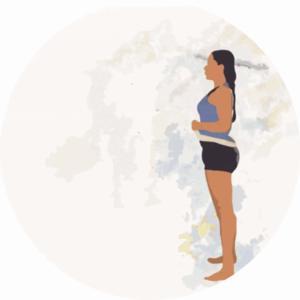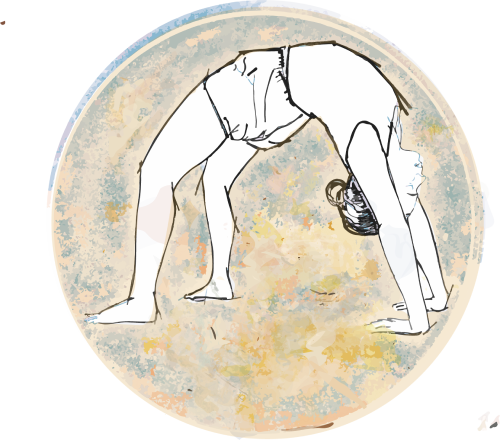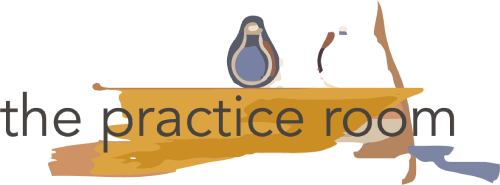We Welcome all Beginners! The best place to start is at the beginning.
Who is a ‘Beginner’ student of Yoga at the Practice Room?
A ‘beginner student’ is not a homogenous category.
– A sedentary adult without much physical activity, looking to transition to a more healthy lifestyle, can be a ‘Beginner’.
– An active person – maybe a runner or a sportsperson – trying to further improve your performance in your chosen field, or hoping to balance some of the imbalances created due to your chosen activity, can be a ‘Beginner’.
– Even a yoga practitioner in another tradition can be a ‘Beginner’.
A ‘Beginner’ is not a comment on your physical abilities or skills. While some beginners are coming for their first yoga class, many ‘Beginner’ level students can be skilled in other kinds of physical activities, including other forms of yoga.
Is Iyengar yoga good for beginners?
Iyengar yoga it is one of the best ways to commence the practice of yoga.
– It follows the precepts of traditional and authentic yoga practice as laid down by sage Patanjali – the codifier of the subject of yoga.
– It integrates scientific concepts, and practical concerns of alignment, strength, flexibility, de-stressing.
– through progressive teaching, attention to detail, and cultivation of rigour, it lays the foundation of a lifetime of practice based on firm foundation.
– Iyengar yoga will help you make a safe beginning – the instructions will be clear, and will be usually accompanied by demonstrations. The instructors are trained to correct you in case you are going wrong, and to suggest adaptations in case you have any health/ physical limitation.
– You will not be made to feel limited if you have poor flexibility, or if you are physically weak – Asanas can be adapted so that you do not feel helpless. You will continue to work within your capacity, and continue to improve.
– You will notice improvement at the level of the body, the mind and and emotions within a very short period of time.
What does yoga do to beginners?/
Yoga aims for nothing less than complete TRANSFORMATION. Anyone practicing yoga for a long time will experience significant changes over a period of time – in their body physiology, and in their mental and emotional state. This translates to better health, better performance in your chosen activity, reduced chances of illness and accidents, better relationship with others in the family and society, a sense of satisfaction and contentment. More immediate consequences are losing weight, improvement in physiological functions like digestion, excretion, circulation, neural and hormonal control. Physical and muscular improvements like becoming flexible and strong, and finding more focus in every day activities.
Does the Practice Room have a Beginner’s Yoga Program?
Our Introductory Courses are suitable both for absolute beginners to yoga, as well as to those with some experience in other traditions of asana practice. In the beginning, the focus is not on perfecting the asanas, but on getting getting comfortable with movement, and in gaining confidence in your ability to work with your arms and legs.
– If this is your first foray into physical activity as an adult, or after a long break, you will start to lose fear, and to enjoy the sense of freedom in your body.
– If you are coming in as an already active person, you will start to appreciate the beauty and intelligence of the asana practice in the Iyengar method, and perhaps identify gaps in your existing physical practices.
– You will also get used to the teaching environment – the teachers, their vocabulary and the use of simple props.
And of course, you will learn asanas.
We allow a progressive curriculum that includes upright, lateral (sideways), forward, backward, twisting, asanas in standing, seated, supine and even upside-down positions.
Students with specific conditions/ limitations are given a basic understanding of the beneficial actions and contra-indicated actions.
Props are introduced, but used with discretion, so that one gets the confidence to use one’s own body.
You can find a broad categorisation of the Introductory Course syllabus HERE (document under revision – to be uploaded soon). But our classes are much more than this listing of asanas. Asanas are broken down into simpler actions, and explained from various perspectives. Classes are interactive, with reinforcements, and adaptations.
Each session at the Introductory level is 60mins..
After going through this introductory course, the students progress to the FOUNDATION level for experienced beginners.
How long is the Beginners yoga course?
“Yoga has a beginning. But no end.”
-Dr. Geeta Iyengar
The introductory period of 2-3 months does not comprise a ‘course’. In our experience this is not enough time to even introduce a beginner-level student to all basic categories of Āsanas that comprise a well-rounded practice (standing, seated, supine, inverted, backward and forward extensions, twisting and abdominal actions, modifying positions using props where required, restorative and rejuvenative positions). Three months is also not enough time for students to gain sufficient knowledge to start practicing independently without supervision.
Yoga is a vast subject, and three months is a mere drop in the ocean. At the end of three months, we hope that you will find the impetus to start your journey with enthusiasm in earnest.
What is the admission process to the Beginners Yoga Program at The Practice Room?
At The Practice Room, we make a systematic start to the learning of yoga. The admission process involves:
Open House/ Personal Meeting – even before classes start, we will meet you, and spend time to clarify your doubts and understand your expectations.
Class Observation – Before you start attending classes, as part of the admission process, we will invite you to come to observe one of our live lasses (we do not offer trial or drop-in classes)
Is the teacher important when one begins to learn yoga? Can I learn yoga without a teacher?
The importance of a teacher, while important for all aspirants of yoga, is especially so for absolute beginners. Mistakes can happen in various levels (physical, physiological, intellectual). A trained and experienced teacher can recognise and correct these mistakes before they turn into dysfunctional habit patterns. Injuries in yoga are not just caused due to falls and accidents, but more insidious injuries are the result of an inability to recognise and correct seemingly minor mistakes over a prolonged period. At the same time, a teacher will can give courage and confidence to the student to go forth without fear, support the student if required, so the student gets the confidence to attempt more challenging actions.
Even if you are disciplined and motivated enough to start a self-practice, in order to constantly progress, to delve deeper into the subject, and to understand its finer intricacies, a teacher will probably be required for a very long time to come.
How often should a beginner do yoga?
Our regular class schedule is usually two classes/ per week. This is enough for a beginner to start to learn the subject, and to maintain a steady schedule that can be balanced with their work/ home life consistently. If they have the time, Beginners can start practicing by themselves whatever has been taught in class. The Practice room also has dedicated time slots for self practice a couple of times during the week – these are open to all enrolled students.
In many other traditions the methodology is to repeat a similar set of actions (a few rounds of surya namaskara, some fixed vinyasa routines) with minor modifications, in almost every class. But each one of our classes is different. These are NOT ‘Practice’ classes. You will LEARN in each class. Too many classes do not give the time to integrate, experiment and practice by yourself what has been taught in class. Eventually (and quite soon) you are expected to start a more regular practice at home. Yoga is a personal practice, and progress will happen only through reflection, analysis and self-practice. The mode of learning in a class is very different from the mode of learning through self-practice.
How can beginners do yoga at home?
The principle of learning any subject are similar: Lean, Reflect, Reinforce, Practice, Apply.
Beginners should practice what has been taught in class.
Unlike many other traditions/ forms of yoga, the sequence of the Asanas in our classes will change from class to class. Usually the teacher sets a ‘theme’ for the class. It is a good practice to write down the sequence after a class, and try practicing it by yourself to reinforces the learnings. Spending a few minutes after each class just mentally going over what was taught, or discussing with one of your classmates, is a good strategy. Geeta Iyengar’s book ‘Asanas in Action – Preliminary Course’ has indicative Asana sequences from the 1st week all the way upto sixth month .
In general, start with standing poses, followed by backbends, twists, forward bends. End with inversions or other supine positions followed by Savasana. If you are dealing with any special conditions, self-practice is the time to really adapt your practice to your specific needs.
Do not set ambitious goals that you cannot sustain. But do try to set aside a definite time of the day and a place in your home for the practice. Even if you are not practicing everyday, and even if your practice sessions are not long, being regular is important. There is no objective yardstick, but 30 minutes, a couple of times during the week, is a realistic beginning.
Read more about home practice/ self practice in this FAQ section of our website.


